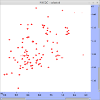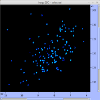

 Ubiquitin is a 76-residue protein that regulates many processes in the biological system by adding it as a substrate (ubiquitination) or subtracting it (deubiquitination). It is regarded as one of the best models for biomolecular NMR and many technologies have been developed using the protein.
Ubiquitin is a 76-residue protein that regulates many processes in the biological system by adding it as a substrate (ubiquitination) or subtracting it (deubiquitination). It is regarded as one of the best models for biomolecular NMR and many technologies have been developed using the protein.
You can try I-PINE with these files (I-PINE results from these inputs):
Ubiquitin sequence (right-click and save link as)
N15 HSQC (right-click and save link as)
HNCACB (right-click and save link as)
CBCA(CO)NH (right-click and save link as)
 Vitamin D Recepter (VDR) is a 262-residue protein that binds Calcitriol (active form of vitamin D). This process is related to transcriptional responses and mechanisms.
Vitamin D Recepter (VDR) is a 262-residue protein that binds Calcitriol (active form of vitamin D). This process is related to transcriptional responses and mechanisms.
You can try I-PINE with these files (I-PINE results from these inputs):
VDR sequence (right-click and save link as)
VDR N15 TROSY-HSQC (right-click and save link as)
VDR HNCO (right-click and save link as)
VDR HNCA (right-click and save link as)
VDR HNCB (right-click and save link as)
 Sterol Carrier Protein-2 from Aedes aegypti (AeSCP-2) is a 110-residue protein that binds lipid nonspecifically. It has been shown that reducing its expression can cause stalled adult development and lowered fertility. AeSCP-2 inhibitors can be developed to insecticides.
Sterol Carrier Protein-2 from Aedes aegypti (AeSCP-2) is a 110-residue protein that binds lipid nonspecifically. It has been shown that reducing its expression can cause stalled adult development and lowered fertility. AeSCP-2 inhibitors can be developed to insecticides.
You can try I-PINE with these files (I-PINE results from these inputs):
AeSCP-2 sequence (right-click and save link as)
AeSCP-2 N15 HSQC (right-click and save link as)
AeSCP-2 CBCA(CO)NH (right-click and save link as)
AeSCP-2 HNCACB (right-click and save link as)
Brazzein is a 53-residue protein from the West African fruit that tastes 500-2000 times sweeter than sucrose. You can try pyIPINE.py with this protein data acquired from BMRB entry 16215. You can download compressed pyIPINE.py and input files (pyIPINE_example.zip). A job can be submitted by $ python pyIPINE.py --in=brz_control.txt --submit. You can download already finished compressed results by $ python pyIPINE.py --job_id=190304_123713_927981 --download and also view web results by $ python pyIPINE.py --job_id=190304_123713_927981 --web. (I-PINE results)
We selected 85 proteins from PDB and BMRB to optimize all the terms and parameters of I-PINE (protein sizes: 24 - 356 a.a.). Synthetic peak lists generated from BMRB are used to test I-PINE. Selection criteria were high assignment completeness, low MolProbity clashscore and a few others. According to our systematic analysis with the given set of data (N15 HSQC, HNCO, CBCA(CO)NH, HNCACB, C13 HSQC, C(CO)NH, H(CCO)NH, HCCH-TOCSY), I-PINE shows significant improvement over PINE. I-PINE provides 5.24 % more assignments with 5.41 % higher accuracy at P=0.5 cutoff.
